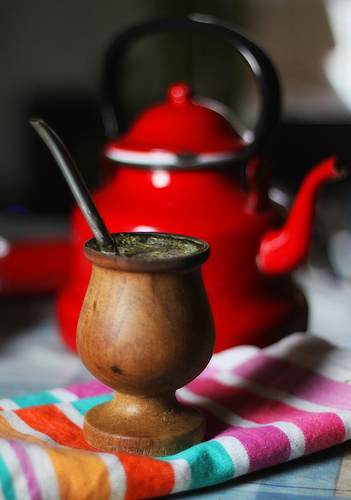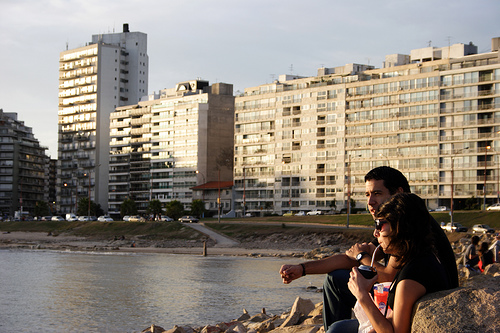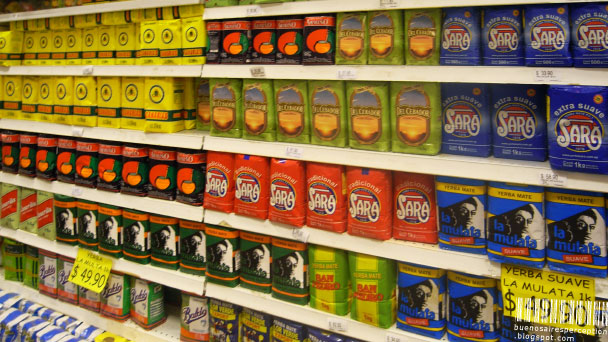Mate. Or Yerba Mate to be technically correct. This herbal infusion is obsessively sipped in Argentina, Uruguay, Paraguay and Southern Brazil. In fact, the beverage is one of the few native traditions that survived the Spanish conquest in South America. Argentines and Uruguayans particularly, ranging from sophisticated urbanites to gauchos, consider the drink a fundamental part of their cultural identity and on average, consume 6-6.5 kilos (14 pounds) per person per year of the dried leaves to make this brew.
For as often as I go to Argentina and Uruguay, this habit never really rubbed off on me—until now. Upon return, I coincidentally stumbled upon a video with the wonderful mate sommelier (yes, you read that right), Karen Johan Lorenzo from Misiones, Argentina, the heart of the growing region. After evaluating the health benefits, I have decided to forego my usual French-press coffee and try mate for a while.
However, mate is more than tea. Let’s get more into this very local tradition, which almost borders on being a ritual.
The Origins of Yerba Mate
First, if you don’t know what Mate is, let’s get that straightened out. Mate is as tea-like beverage brewed from the dried leaves and stemlets of the perennial tree Ilex paraguarensis (“Yerba Mate”). It actually has ancient origins as it was introduced to the world by the Guaraní Indians. The name “Mate” derives from the quichua word “matí” that names the gourd (Lagenaria vulgaris) that is traditionally used to drink the infusion, usually though a long metallic straw called a bombilla.
The tree belongs to the family Aquifoliaceae and grows between the parallels 10° and 30° (South) in the subtropical Paraná and Paraguay rivers basins. It is a typical plant typical of the Alto Paraná region, Alto Uruguay region and Northeastern Argentinean provinces of Misiones and Corrientes. As a tropical or subtropical plant, it needs fairly high temperatures, high humidity and up to 60 inches of annual rain. The plant needs about 25 years to develop completely. It has a characteristic mature flavor that is somewhat sweet, bitter, withered leaf like, and alfalfa-like. Of the 196 volatile chemical compounds found in Yerba Mate, 144 are also found in tea. This means it’s crazy good for you.
Argentina is the prime producer, consumer, and exporter of mate. The other markets outside the immediate area of South America are principally Lebanon and Syria, which do share the same ritual—but not the same cup or straw!
How to prepare a traditional Mate infusion
Yerba Mate is essentially an herbal tea. In its most popular version, it comes as loose-leaf teas that are dried and somewhat ground. They also sell them in tea bags (US market) since Americans are less likely to drink them as they traditionally would in South America.
While I am going to outline below the exact technique to make a traditional mate, you can also drink it like normal loose-leaf tea, steeped in a tea pot, and filtered before pouring into a cup. I am getting good results in my coffee press, where the herb is infused with hot water (note: NOT BOILING), and then the herb is pressed out of the way of the tea. I am even seeing iced versions of it in the summer time in Argentina like herbal iced tea.
But let’s suppose that you have a mate gourd, or cup, along with the bombilla. Here’s how to do it old school (and how 99.99% of Argentines, Uruguayans, Paraguayans, and Southern Brazilians will do it). This process in Spanish is called cebar el maté.
- Place the dried, minced mate leaves in the gourd. Fill it up to about ¾ capacity with the dried herb.
- Pour in hot water, not boiling (around 176-185F), leaving some of the outer leaves to “nurture” subsequent mates (remember, they never ever have just one).
- Let the infusion stand 10-15 seconds. Add more hot water as the first one is absorbed.
- Add the bombilla, strainer end down, to the mate. Sip slowly (hot, hot!).
Some people add sugar, or stevia (which is a natural sweetener from Paraguay). With kids in Argentina, they replace milk for water. So how do you know how many infusions you get from a maté? Well, since people are literally drinking this like water, when the characteristics, bitter green taste is almost gone, that means you need to change the dried herb.
More than an infusion
Mate is more than a drink. It is deeply rooted in the collective consciousness of its drinkers as an intimate part of daily culture. In Argentina, the traditional mate gourd and bombilla is shared among close friends and family who use the same straw and gourd. It’s a symbol of camaraderie, unity, a bond. It is a sign of acceptance and friendship. When I asked many friends why they take their mate everywhere with them (gourd, bombilla, and hot water thermos to replenish), it was almost innate, something that accompanied you everywhere. A faithful companion on which you can rely during the day.
In Buenos Aires or on the Rambla of Montevideo, I began to observe when mate was consumed. Among families or lovers, friends fishing off a pier, hanging out in a park, on the sidelines of a soccer game, and even when driving. One of our guides in Mendoza, Santiago, has a knack for being able to drive a stick shift and pour water, at the same time, into his mate gourd while being in heavy, moving traffic (with unpredictable Argentine drivers…). Uh huh.
However, since it is a ritual, here are a couple tips on how to handle mate if you are sharing in a social situation. If you are the one serving it, you get first dibs. You drink ALL the water before passing it off. The next person fills up the gourd with water and once again, drinks everything. This process continues until everyone has had their mate—or the herb is rendered tasteless.
It’s so good for you
Karen Johan Lorenzo, the mate sommelier, first qualifies in her presentation that mate is truly a food, more than an herbal tea. It is chock full of vitamins, amino acids, and has more antioxidants than green tea.
Actually, chew on this. Argentines and Uruguayans consume about 33 kilos (about 73 pounds) of red meat (grass fed) per year along with countless liters of milk and dairy. However, it’s very, very rare to see any obese people here and heart disease incidences are lower than in the US where processed food is rampant. Hmm, could mate have something to do with that? Maybe so. Scientist Elvira de Mejia at the University of Illinois learned from a lab study at the university that the enzyme that produces HDL, or good cholesterol, increases activity levels in people who drink mate tea. Drinking mate tea also lowers LDL levels, or bad cholesterol.
Mate is also an energy drink. The Guaraní Indians consumed it all day to keep hunger at bay and their energy high when working or traveling. And even though mate contains caffeine, mate also has mateina, a kick along with xanthine alkaloids: one is a stimulant found in tea, and another is the mood elevator and muscle relaxant found in chocolate. Should I keep going? It’s loaded with B vitamins, which nourish the nervous system and raise metabolism. For more info on health benefits, read here. However, many sports enthusiasts have discovered it worldwide and have tossed caffeine-based stimulants for the all natural option.
I would also add that sipping mate is quite calming, even somewhat zen, which has become a nice habit to incorporate to mitigate the stress of the day. It also has a more interesting flavor than sipping pure water all the time, especially in the winter when it’s chilly.
So give mate a try. I am definitely warming up to it and incorporating the habit. Maybe on my next trip to Argentina in September I will invest in the classic gourd and metal straw…and seguro, partake with my friends there.
Photo credits: Thanks to Dhammza for the beautiful pics of the gourd; Ostroksy for capturing the common site on Mate on the Rambla in Montevideo (Pocitos); and the blog Buenos Aires Perception for the supermarket shot in Uruguay.















